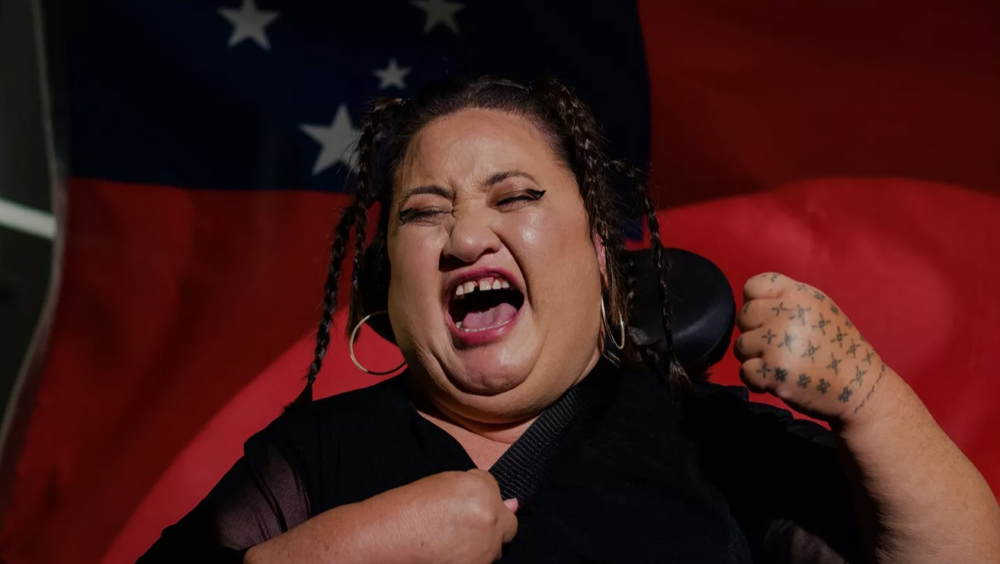Te Pou Theatre
Auckland
20 March 2024
Reviewed by Jenny Stevenson

Photograph: Jinki Cambronero
Lusi Faiva’s new work Aiga created in conjunction with Touch Compass for Auckland Arts Festival is what the French so aptly call a “cri de coeur” - a cry from the heart. It is a cry that demands to be heard and one that emerges from a Pasifika cultural perspective. The cry is from Faiva herself: for acceptance of those who are often marginalised; for recognition of diverse identities; and as a plea to be seen and heard as an individual who has hopes and desires. It emerges as inclusive theatre in every sense of the word, working to give voice to those whose stories are not always easy to hear.
When pioneering dance artist Catherine Chappell first created the inclusive dance company Touch Compass 27 years ago, Lusi Faiva who uses a wheelchair, was a founding-member. In the intervening years Faiva has developed her artistic vision and her cultural connections to arrive at the assured position she now occupies in the company, as she recounts for us this saga of her life thus far.

Photograph: Courtesy of Te Pou Theatre

Photograph: Jinki Cambronero
Aiga, meaning “family” or “whānau” is a collaborative, multi-dimensional work which has come to fruition through the combined talents of Faiva and a group of top-notch artists, whose input has been deftly woven into a cohesive production by Director, Moana Ete. Although it is underpinned by dance throughout, theatrical elements of narration, dialogue and song and visual elements of design are of equal importance in interpreting Faiva’s story.
The four performers all have an easy charm and are at home in their characterisations. Faiva herself projects an intense vulnerability that is both moving and endearing. She has a compelling presence onstage, dancing by using her arms in siva-like undulations while gliding in wheeled formations. Her potent cries of sorrow or rage inform her performance with veracity. By the end of the work she celebrates her success in overriding the forces that undermined her early life to emerge as a “Warrior” who flies “hand-in-hand with Nafanua” (the Samoan Goddess of War). While Faiva’s ability to speak is limited, she is able to address the audience directly using words from her iPad projected onto a screen.

Photographs: Jinki Cambronero

Forest V Kapo one of the chorus of dancing three graces who aid Faiva in recounting her story performs a captivating solo and delivers a deliberately-garbled diagnosis as the Doctor who first diagnoses Lusi as a young child. The innocence and incomprehension of Lusi’s mother, Timu’ia, played by Iana Grace, illustrates how difficult it was for a newly arrived young woman from Samoa to understand, when her daughter Lusi was placed in an institution. Lusi notes wryly “My mother gave me life and did the best she could…which wasn’t enough.” Fiona Collins who has written the script is the fourth performer and exudes joy in her various roles particularly when dancing a beautiful Siva.
The design aspect of Aiga is a major contributor to the success of the work. Hanging in the foyer of Te Pou as the audience wait to enter the theatre, is an enormous lei of welcome, constructed from brown paper in a design by Linda Lepou. She uses the same design to construct huge hibiscus and other adornments to enhance the simple black costumes worn by the performers. Spatial and AV Designer Rowan Pierce aims to create “a transcendent experience – where design acts as a performer in itself”. In this instance it is totally apt: the three red screens on wheels are danced by the cast into various positions and act as shadow screens when lit from behind. Similarly the enormous, fixed position, prow-shaped screens enable giant-size projections to loom up out of the darkness and various boxes manipulate the space to enhance the action.
The story of Lusi’s institutionalisation, her rescue by a devoted couple of mentors, her dreams of a father and many other aspects unfolds in a delightfully meandering format. The finale of the work as Faiva forcefully lays claim to her place in the world is wonderfully uplifting and many in the audience jump up to join in the dancing, surrounding Faiva, while acknowledging her, seemingly reluctant to let the performers go.

